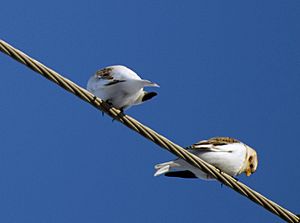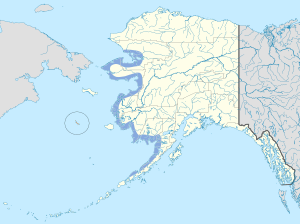McKay's bunting facts for kids
Quick facts for kids McKay's bunting |
|
|---|---|
 |
|
| Conservation status | |
| Scientific classification | |
| Genus: |
Plectrophenax
|
| Species: |
hyperboreus
|
 |
|
The McKay's bunting (Plectrophenax hyperboreus) is a small bird that belongs to the longspur family. It looks a lot like the snow bunting, and sometimes they even have babies together! Because of this, some experts think the McKay's bunting might just be a special type of snow bunting. These birds live and breed on two islands in the Bering Sea: St. Matthew and Hall islands. When winter comes, they fly to the western coast of Alaska. The bird was named after the American naturalist Charles McKay.
Contents
What Does the McKay's Bunting Look Like?
The McKay's bunting looks very similar to the snow bunting, but it's much whiter.
Colors and Patterns
When it's time to breed, the male McKay's bunting is almost completely white. It only has small black areas on its wingtips and tail. The female during breeding season has some streaks on her back. Birds that are not breeding have warm brown patches. These patches can be found on their cheeks, the top of their head, and the sides of their neck.
Size and Weight
McKay's buntings are usually a bit bigger than snow buntings. They are about 18 cm (7.1 in) long. They weigh between 38 to 62 g (1.3 to 2.2 oz), with an average weight of 54.5 g (1.92 oz). Their wings are about 10.1 to 12.2 cm (4.0 to 4.8 in) long. Their tail measures about 6.4 to 7.5 cm (2.5 to 3.0 in). The bill, which is their beak, is 1.1 to 1.3 cm (0.43 to 0.51 in) long. Their leg (tarsus) is about 2 to 2.4 cm (0.79 to 0.94 in) long.
Life and Habits
This bunting builds its nests on rocky beaches. They often use hollow logs or cracks in rocks for their homes.
Where They Live in Winter
In winter, these birds move to different places. They can be found on coastal marshes, which are wet grassy areas near the sea. They also like shingle beaches, which are beaches made of small, smooth stones. Sometimes, they even visit farm fields.
What They Eat
Scientists believe that McKay's buntings eat similar things to snow buntings. In winter, they mostly eat seeds from weeds and different types of grasses. In the summer, their diet changes. They enjoy a mix of seeds, plant buds, and insects.
Status and Protection
The total number of McKay's buntings is thought to be less than 6,000 birds. Even though they are not in immediate danger, their population is quite small.
Threats to the Population
These birds could be in big trouble if certain animals are brought to their islands. For example, if rats, weasels, or foxes were introduced, they could cause a lot of harm. These animals might eat the birds or their eggs, which could quickly reduce the bunting's numbers. Protecting their island homes is very important for their future.
See also
 In Spanish: Escribano de McKay para niños
In Spanish: Escribano de McKay para niños


